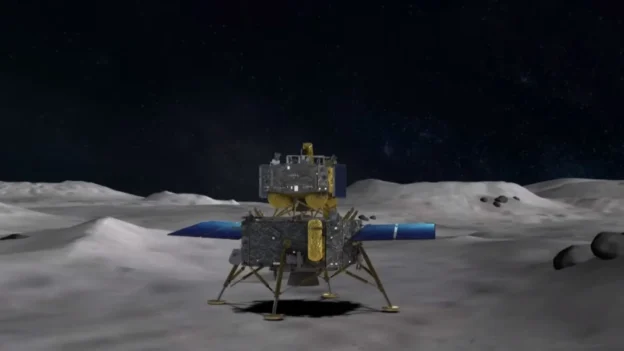The Chang’e-6 lander/ascender array mission, supported by the Queqiao-2 relay satellite, successfully landed in the pre-selected area of the Aitken Basin, located at the South Pole of the Moon’s far side, last Sunday, June 02.
The Chang’e-6 mission
On the same day, the Chang’e-6 module module began its shutdown process, activating the 7,500 N variable thrust main engine. During this phase, the array made rapid attitude adjustments as it gradually approached the lunar surface.
The autonomous obstacle avoidance system detected obstacles using a visible light camera to select a safe spot based on the brightness of the lunar surface. Once located, it positioned itself 100 meters above that point and used a 3D laser scanner to take accurate photographs, thus identifying obstacles on the lunar surface.
Finally, after selecting the landing site, the assembly descended slowly and vertically. Shortly before touching the lunar surface, the engine shut down, allowing the module to land softly in the Aitken Basin at the South Pole.
The Chang’e-5 mission experience
In the past 2020, it achieved a sample return from the lunar front, the Chang’e-6 mission is a different event, implementing humanity’s first lunar background sample return. This mission presents numerous engineering innovations, high risks and major challenges. Backed by the Queqiao-2 relay satellite.
On the other hand, payloads carried by the Chang’e-6 lander will operate as planned, carrying out scientific exploration missions. In this regard, the mission’s international payloads, which include the European Space Agency’s lunar surface negative ion analyzer and the French lunar radon detector, are ready to start operations, while the Italian laser corner reflector has already been deployed.
Since its launch, the Chang’e-6 probe has undergone several processes, such as Earth-Moon transfer, braking near the Moon, circumlunar flyby, and landing and descent. The probe is composed of an orbiter, a returner, a lander and an ascender. After the successful landing, the module, via the Queqiao-2 relay satellite and under ground control, will carry out status inspections and configuration work, such as the deployment of solar wings and directional antennas. Thus, the lunar mission will officially begin.

The hidden face of the moon uncovered. Source: SciNews
In addition, for the subsequent sampling work, soil and lunar rock samples will be collected by drilling with specialized tools and robotic arms, thus achieving an automatic multipoint and diversified sampling. At the same time, scientific explorations will be carried out, such as the“in situ” investigation and analysis of the lunar landing zone on the far side of the Moon, as well as the study of the structure of the lunar soil.
Follow us on social networks and don’t miss any of our publications!
YouTube LinkedIn Facebook Instagram X
Source: CNSA
Photo: CCTV Video News Agency


